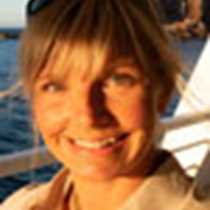Our expedition continued today with a wonderful morning spent on the ship exploring and learning about the history of the Lewis and Clark expedition on the Columbia River and travelling through the John Day Dam. We then docked National Geographic Quest in The Dalles and stepped off the ship into a bit of a weather shift, with a misty cloud around us that filtered our experience and whetted our taste for adventure. Though the conditions were slightly damp, we were ready to get out and explore our new location.
This afternoon, we excitedly started our exploration with a drive on the Historic Columbia River Highway, the oldest scenic highway in the United States. Our first stop was a visit to Rowena Crest, an iconic viewpoint on the Oregon side of the Rowena Gap and part of Oregon’s Mayor State Park. Our drive up the Historic Highway was filled with spectacles of yellow, green and orange leaves, the signs of changing fall colors on big leaf maple and quaking aspen. Even through the clouds from up high on a cliffside with the gorge below, we were able to look across the Columbia River to the town of Lyle, Washington and at the mouth of the Klickitat River.
After visiting Rowena Crest, we returned riverside to experience the wonderful displays at the Columbia River Gorge Discovery Center (CGDC). It was here that we were able to learn more about the incredible significance of The Dalles, in Oregon Trail history. It was specifically in this area that in the 1840s, American settlers began to arrive overland on the Oregon Trail. Due to the steep cliffs of the Gorge, it was impossible to take wagons further west on the Oregon Trail without rafting down the river from The Dalles. Before construction of the Barlow Road in 1846, reaching Willamette Valley and Fort Vancouver was beyond a treacherous task and required risking losing everything to continue travelling west via raft on the Columbia River beginning in The Dalles.
In addition to the fascinating historical displays we were able to enjoy at the Columbia River Gorge Discovery Center, we took part in a presentation of live birds of prey from the CGDC’s Raptor Project. Through the project’s educational programs, we learned more about the present challenges local birds like the red-tailed hawk, the American kestrel, the Cooper ’s hawk and the great horned owl face in this area such as habitat loss and hazardous toxic chemicals. Spending time with the rescue birds was an excellent addition to the historical journey around the Discovery Center.
The afternoon was completed with optional excursions in The Dalles, including a botany and nature walk with naturalists exploring Lewis and Clark catalogued native plants, a fast-paced 6-mile walk to the ship, a chance to ride bicycles alongside the Columbia River and a photography-instruction themed walk with a National Geographic photographer and a National Geographic photo instructor. It was difficult for us to choose between the excellent options, but our varying adventures were shared over laughs and delicious appetizers when we all came together again in the evening on the ship.







